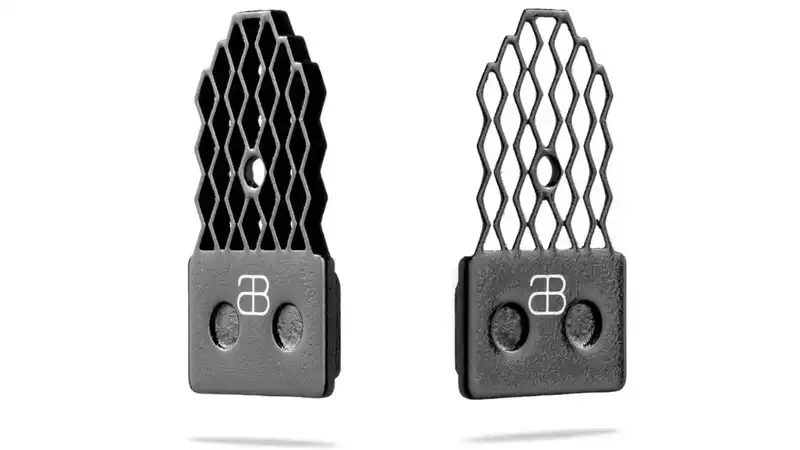Given the scarcity of disc brake pads, it's nice to see a new option come to market. Brake pads, rare or not, are the least attractive of all bike parts, and when it comes to replacement, many are guilty of settling for what is available and inexpensive. [But AboluteBLACK has brought to market Graphenpads, a new brake pad with options for Shimano road, mountain bike, and SRAM calipers, new material technology, and a cooling fin design reminiscent of an industrial fence. Bold performance claims and even bolder pricing - would you throw down £100 for a full set of pads?
Disc brake pad compounds are usually defined in the collective consciousness as either sintered or organic. But to understand what is new about these pads, one must delve into the murky surface of resins and friction modifiers.
In general, brake pads consist of something that grips, something that slides, and something that holds the pad in place. Too much grippy compound (e.g., ceramic particulates) will cause the pad to grip too much and wear the rotor. To bring the pad compound back to optimum performance, a "friction modifier" (essentially slippery particles) is added. This is like taking spirits straight from the distiller and splashing them with spring water to make a palatable vodka instead of pure ethanol.
Most pads use copper powder as a friction modifier, but since the state of California has decided to ban the use of copper powder after 2025 due to its toxicity to aquatic life, absoluteBLACK has chosen to use graphene particles instead. The particles not only modify friction to a desirable level, but also, due to their thermal conductive nature, conduct thermal energy from the braking material to the pad backer plate, improving pad heat dissipation.
Furthermore, the metal is slightly porous on the microscale, despite its seemingly impenetrable nature. In addition to the standard claims of improved braking performance, the graphene pads have the added benefit of extending rotor life. Theoretically, as the pads wear, the tiny, highly durable graphene particles penetrate the pores of the brake rotor, improving wear life.
This is not the first brake pad to employ cooling fins; Shimano pads have had them for several years. Their purpose is to reduce brake fade by dissipating heat from the rotor and pad, sending it to a finned cooling area that provides a large surface area for air to flow through to dissipate heat.
The fins of the Shimano pad are made of parallel metal, and while they certainly provide a heat sink, the radiant heat from one fin will hit the adjacent fin directly. The mesh structure of this graphene pad instead uses a 45-degree angled surface, which not only avoids reheating due to radiant heat, but also promotes air flow over the surface, according to the company. This works in conjunction with the thermally conductive graphene coating mentioned above.
These features, which took three years to develop, are claimed to provide quiet braking without fading, even on long descents. Priced at £49.99 for the pair, or just under £100 for the full set of front and rear pads, there is no doubt that there is a noticeable difference in performance and longevity compared to standard pads. Or is it simply available for purchase.
And on the last point, they can be purchased on the Absolute Black website.
.

Comments